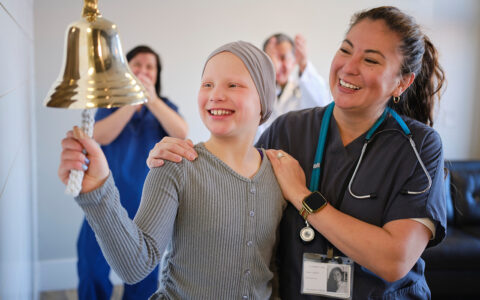The standard of care for children with cancer and a central line who present with fever has been to administer an antibiotic within 60 minutes.
This timing metric, extrapolated from adult studies, became incorporated in 2011 by the U.S. News and World Report (USNWR) hospital ranking system, which shaved points from centers that failed to meet the threshold 95 percent of the time.
This year, however, USNWR’s rankings will not include the time-to-antibiotic (TTA) metric thanks largely to a study led by Adam Esbenshade, M.D., of Monroe Carell Jr. Children’s Hospital at Vanderbilt.
His research, published in 2023, provided robust evidence that the 60-minute TTA goal does not move the needle on outcomes. In fact, Esbenshade says, it can confound appropriate individualized treatment and cause patient distress, or even harm.
“There is zero evidence that speed is the most important thing.”
“Speed is important if things are going poorly, but otherwise, there is zero evidence that speed is the most important thing,” said Esbenshade, who holds the John N. Lukens Jr. Chair in Pediatric Hematology-Oncology at VUMC.
“The TTA guidance was not allowing for discretionary calls without the threat of a ‘ding’ on the USNWR score. As result, what was originally intended to help stems delays in care became a disincentive to take more prudent steps.”
No Difference in Outcomes
To assess the potential benefits of adhering to the 60-minute mark, Esbenshade’s team analyzed records on 2,349 episodes of pediatric cancer patients with central lines presenting with fever either at the Monroe Carell ED, at a clinic, as a transfer from an outside hospital, or as an inpatient. They also looked at 429 ED episodes from Children’s Hospital Colorado.
The median TTA for the cohort was 56 minutes, with just over half receiving antibiotics in less than 60 minutes. Yet, no negative trend in clinical outcome was recorded in the remaining 46 percent that missed the deadline.
“Our conclusions stood, after we sliced and diced the data along many parameters – including adjusting for significant clinical variables prior to presentation and examining outcomes at six hours, 24 hours, and one week,” Esbenshade said.
In previous studies, his team found this cohort of children who presented with fever were non-neutropenic in more than 60 percent of cases. Even among those with neutropenic test results, less than 20 percent had a bacterial infection.
Esbenshade said in trying to adhere to the USNWR criterion, some patients were being prescribed antibiotics before their CBC test results were back, a potentially unnecessary or ineffective response.
“In non-neutropenic fever, the odds of the child having a bacterial infection is only about 4 percent. Even if they have a bacterial infection, if it’s not making them systemically ill, then you have time for evaluation,” Esbenshade said.
In 2015 Monroe Carell implemented a risk prediction model – the Esbenshade Vanderbilt Model – that helps identify low-risk patients that don’t need initial treatment with antibiotics. The model has been applied in over 2,500 cases across 18 medical centers without negative outcomes.
“This is huge in helping avoid antibiotic resistance and not wiping out the child’s microbiome unnecessarily,” he said.
Shot Foils Treatment
In some cases, patients were given an intramuscular ceftriaxone injection at 55 minutes post-presentation, even without absolute neutrophil count or blood culture results.
“This painful shot can cause severe bruising in a child with low platelet levels from chemotherapy, and targets only 45 percent of bacterial infections,” Esbenshade said. “It seems extreme for children who are well-appearing.”
There’s also a risk of hemolysis from drug interaction between the ceftriaxone and the anti-pseudomonal that may be given once the complete blood counts comes back, he said.
The alternative – giving children an anti-pseudomonal antibiotic to target the more likely Gram-negative culprits – requires central line access and is often not necessary, Esbenshade says.
“You could lose by giving the wrong antibiotic by the wrong route, and sterilizing the blood culture in the process,” he said. “Plus, it can delay getting the right antibiotic started.”
New Guidance
Esbenshade says it is prudent for every child in this population to come to the hospital if they develop a fever and, for those who appear ill, an anti-pseudomonal IV antibiotic administered rapidly is important. If a patient appears well, however, the data supports waiting for the absolute neutrophil count, and potentially the culture, as well.
“We still want people to be assessed and labs drawn quickly. We just don’t want to reflexively give antibiotics to children who might not even be neutropenic,” he said. “Furthermore, we do not think the solution is to select a different time metric, as we did not find any time cutoff that was prognostic. Rather, quick recognition of sick patients is the key.”
Up next for Esbenshade is a prospective multisite study of the same population.
“We think this research we have done will change national practice,” he said. “Now, we want to see if there are any signs that there is a subpopulation, yet uncovered, where a 60-minute TTA matters.”






